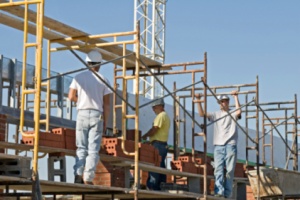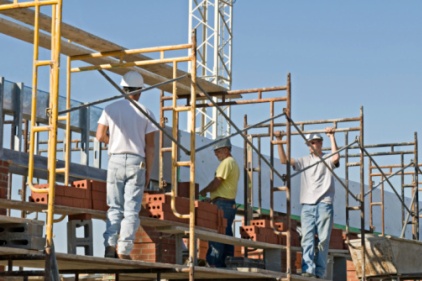 More construction workers (849) were killed on the job in 2012 than in any other industry, according to the Bureau of Labor Statistics’ Census of Fatal Occupational Injuries (CFOI). That figure also represents the first increase in construction deaths since the country’s economic downturn.
More construction workers (849) were killed on the job in 2012 than in any other industry, according to the Bureau of Labor Statistics’ Census of Fatal Occupational Injuries (CFOI). That figure also represents the first increase in construction deaths since the country’s economic downturn.
A Data Brief issued by the Center for Construction Research and Training (CPWR) Data Center reveals that between 2011 and 2012:
• The number of Hispanic construction workers killed on the job increased by 12.7 percent – to 222 – compared with an 8.7% increase for the overall construction industry
• The fatality rate of older construction workers (aged 45+) was 15.2% compared to 1.9% among their younger counterparts
• Among self-employed construction workers, the number of fatalities increased 27.8% from 2011to 2012 while the increase among wage-and-salary workers was 4.4%.
• There were 199 fatalities in residential construction1 in 2012 — an annual increase of 37.2% compared to just a 3.0% increase in nonresidential construction.
• Fall fatalities in all construction increased 9.3% from 269 to 294 between 2011 and 2012, but jumped 81.5% in residential building construction from 27 to 49 deaths.
KEY FINDINGS
The brief, by Xiuwen Sue Dong, DrPH, Julie A. Largay, MPH, and Xuanwen Wang, PhD, noted that the construction industry in the U.S. employed nearly 9 million workers in 2012, slightly fewer than in 2011. However, the average hours worked per week increased from 42.1 to 42.6.
Residential building construction was more volatile than nonresidential building construction during the economic boom and decline (Chart 2). Residential building construction grew by 20% between 2003 and 2006 and was down 32% in 2010 from the 2003 level. Although there was also a decline in nonresidential building construction, it was less severe (11%).
“Although construction employment remained low in 2012, construction fatalities increased for the first time since 2006,” note the authors. “In 2012, more workers died in construction than in any other major industry, and accounted for 18.3% of all work-related fatalities in the United States.”
While the number of fatalities increased 8.7% nationwide, in North Dakota, the number nearly tripled — from 9 to 25. The number of fatalities more than doubled in Virginia.
“By age group, the largest percent increase in fatalities was among the 55-64 year age group. When comparing younger workers (aged 18-44) with older workers (aged 45+), the difference was striking: a 15.2% increase for older workers, and a 1.9% increase for their younger counterparts. This may mirror the
aging workforce.”
| Despite the lower heights typically associated with residential construction, the annual change in fatalities among residential roofing contractors was more than double the increase in their nonresidential counterparts. |
Other statistics highlighted in the Data Brief:
Among construction occupations in the private sector, laborers had the largest number of fatalities. Between 2011 and 2012, the number of fatalities increased from 171 to 191— a 12% increase for this occupation. Foremen had the second highest fatality numbers, jumping from 88 in 2011 to 98 in 2012. Overall, most construction occupations (except a few, such as operating engineers and power-line installers), experienced an increase in fatalities during the time period.
The changes in construction fatalities differed by employment class. While the increase in the number of fatalities among wage-and-salary workers in construction was 4.4% between 2011 and 2012, the increase was 27.8% among the self-employed . The annual change in the number of fatalities was 41.9% among self-employed specialty trade contractors.
Fatality numbers varied between residential and nonresidential construction.1 Between 2011 and 2012, the number of fatalities in residential subsectors increased by 37.2% compared to just a 3.0% increase in nonresidential subsectors. Despite the lower heights typically associated with residential construction, the annual change in fatalities among residential roofi ng contractors was more than double the increase in their nonresidential counterparts. Conversely, a decrease in fatalities was found in nonresidential building and nonresidential specialty trade contractors in 2012.
Fall injuries were the leading cause of fatalities in 2012. In fact, the proportion of construction fatalities resulting from falls has remained high since 2003, and the number of fall fatalities increased from 269 in 2011 to 294 in 2012.
While the number of fall fatalities in overall construction increased 9.3% between 2011 and 2012, the number jumped by nearly 82% in residential building construction — from 27 to 49 deaths. Fall fatalities in residential roofi ng increased by 53% between the two years. In contrast, the number of fatal falls in nonresidential building construction decreased 4% over this period.
In 2011, the CFOI began coding falls by height of fall. Between 2011 and 2012, the number of fall fatalities increased by 7% for falls from 30 feet or below and dropped by 7% for falls from over 30 feet. This may reflect the fatality increase in residential construction1 as heights of more than 30 feet may be less common in these subsectors.
Falls continue to account for more construction fatalities than any other injury type. To prevent fall injuries among construction workers, CPWR is collaborating with OSHA and the National Institute for Occupational Safety and Health (NIOSH) on a national fall prevention campaign. The largest increases in construction fatalities were found among older workers, self-employed workers, roofing contractors, and workers employed in residential construction. Construction safety and health interventions and prevention strategies should focus on these vulnerable worker groups and subsectors.
About the CPWR Data Center
The CPWR Data Center is part of CPWR – The Center for Construction Research and Training. CPWR is a 501(c)(3) nonprofit research and training institution created by the Building and Construction Trades Department, AFL-CIO, and serves as the research arm of the BCTD. CPWR has focused on construction safety and health research since 1990.
Previous data briefs are available on the CPWR website, http://www.cpwr.com/publications/cpwr-data-briefs.



